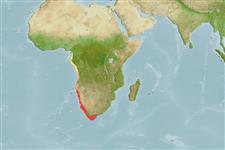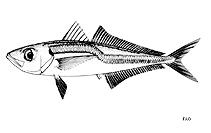Add your observation in Fish Watcher
| Native range | All suitable habitat | Point map | Year 2050 |

|
| This map was computer-generated and has not yet been reviewed. |
| Trachurus capensis AquaMaps Data sources: GBIF OBIS |
Upload your photos and videos
Pictures | Google imageTrachurus capensis
Picture by FAO
Pictures | Google imageTrachurus capensis
Picture by FAO
Common names from other countries
Classification / Names প্রচলিত নাম সমূহ | প্রতিনাম সমূহ | Catalog of Fishes(গণ , প্রজাতি ) | ITIS | CoL | WoRMS | Cloffa
> Carangiformes (Jacks) > Carangidae (Jacks and pompanos) > Caranginae
Etymology: Trachurus: Greek, trachys, -eia, -ys = rough + Greek, oura = tail (Ref. 45335).
More on author: Castelnau.
Etymology: Trachurus: Greek, trachys, -eia, -ys = rough + Greek, oura = tail (Ref. 45335).
More on author: Castelnau.
Environment: milieu / climate zone / depth range / distribution range বাস্তুসংস্থান
সামুদ্রিক; গভীরতার পরিসীমা 0 - 500 m (Ref. 54925), usually 100 - 300 m (Ref. 54925). Subtropical; 7°N - 37°S, 4°E - 24°E (Ref. 54925)
বিতরণ দেশ সমূহ | এফ এ ও এলাকাসমূহ | বাস্তুতন্ত্র | দৃষ্টিগোচর | Point map | প্রচলন | Faunafri
Eastern Atlantic: Gulf of Guinea to South Africa. Bianchi et. al. 1993 notes 'Smith-Vaniz (1992, pers. comm.) does not believe that Trachurus capensis is a valid species but admits that an adequate series of this species along the coast of Africa are not available'.
Length at first maturity / আকৃতি / ওজন / Age
Maturity: Lm 32.5, range 20 - 33 cm
Max length : 60.0 cm FL পুরুষ/ লিঙ্গ অনিধর্ারিত ; (Ref. 3166); common length : 30.0 cm FL পুরুষ/ লিঙ্গ অনিধর্ারিত ; (Ref. 3166)
Max length : 60.0 cm FL পুরুষ/ লিঙ্গ অনিধর্ারিত ; (Ref. 3166); common length : 30.0 cm FL পুরুষ/ লিঙ্গ অনিধর্ারিত ; (Ref. 3166)
Adults are found mainly over the continental shelf, often over sand bottoms (Ref. 27121). Shoals rise to feed in surface waters at night and found close to the bottom during the day (Ref. 27121). Juveniles feed mainly on copepods while adults prey on fish and a wide range of invertebrates (Ref. 27121).
Life cycle and mating behavior পরিপক্কতা | প্রজনন | ডিম ছাড়া | ডিমসমূহ | ডিম্বধারন ক্ষমতা | শুককীট
Main reference
Upload your references | সূত্র সংখ্যা | সমম্বয়কারী : Smith-Vaniz, William F. | সহযোগী
Smith-Vaniz, W.F., J.-C. Quéro and M. Desoutter, 1990. Carangidae. p. 729-755. In J.C. Quero, J.C. Hureau, C. Karrer, A. Post and L. Saldanha (eds.) Check-list of the fishes of the eastern tropical Atlantic (CLOFETA). JNICT, Lisbon; SEI, Paris; and UNESCO, Paris. Vol. 2. (Ref. 7097)
Threat to humans
Harmless
Human uses
মৎস্য: অত্যন্ত বাণিজ্যিক
FAO(মৎস্য: উৎপাদন , species profile; publication : search) | FishSource | আমাদের চতুর্পাশ্বের সাগর
আরো তথ্য
Population dynamics
Growth parameters
Max. ages / sizes
Length-weight rel.
Length-length rel.
Length-frequencies
Mass conversion
নির্বাচন
প্রাচুর্য
Growth parameters
Max. ages / sizes
Length-weight rel.
Length-length rel.
Length-frequencies
Mass conversion
নির্বাচন
প্রাচুর্য
Anatomy
ফুলকা এলাকা
Brain
Otolith
ফুলকা এলাকা
Brain
Otolith
Physiology
Body composition
Nutrients
অম্লজান ব্যবহার
-এর সাতাঁরের ধরণ
সাতাঁরের গতি
Visual pigments
Fish sound
Diseases & Parasites
Toxicity (LC50s)
Body composition
Nutrients
অম্লজান ব্যবহার
-এর সাতাঁরের ধরণ
সাতাঁরের গতি
Visual pigments
Fish sound
Diseases & Parasites
Toxicity (LC50s)
Genetics
বংশানুগতিবিদ্যা
Heterozygosity
উতরাধিকার সুত্রে পাওয়া যোগ্যতা
বংশানুগতিবিদ্যা
Heterozygosity
উতরাধিকার সুত্রে পাওয়া যোগ্যতা
Human related
Aquaculture systems
একুয়াকালচার নকশাসমূহ
বংশ
Ciguatera cases
Stamps, coins, misc.
Aquaculture systems
একুয়াকালচার নকশাসমূহ
বংশ
Ciguatera cases
Stamps, coins, misc.
হাতিয়ার
E-book | মাঠ পর্যায়ের নির্দেশক | দৈঘ্যর্ের ঘটন সংখ্যা জাদুকর | জীবন ইতিহাস হাতিয়ার | মানচিত্র নির্দেশ করুন | Classification Tree
| Catch-MSY |
Special reports
Download XML
ইন্টারনেট সুত্র
Aquatic Commons | BHL | Cloffa | Websites from users | Check FishWatcher | CISTI | Catalog of Fishes(গণ , প্রজাতি ) | DiscoverLife | ECOTOX | Faunafri | Fishtrace | GenBank(genome, nucleotide) | GloBI | GOBASE | | Google Books | Google Scholar | Google | IGFA World Record | MitoFish | Otolith Atlas of Taiwan Fishes | PubMed | Reef Life Survey | Scirus | SeaLifeBase | জীবন বৃক্ষ | Wikipedia(Go, অনুসন্ধান ) | World Records Freshwater Fishing | Zoobank | জুলজিকাল রেকর্ড
Estimates based on models
Preferred temperature (Ref. 115969): 9.2 - 15.2, mean 11.2 (based on 76 cells).
Phylogenetic diversity index (Ref. 82804): PD50 = 0.5001 [Uniqueness, from 0.5 = low to 2.0 = high].
Bayesian length-weight: a=0.01023 (0.00629 - 0.01666), b=2.94 (2.80 - 3.08), in cm Total Length, based on LWR estimates for this species & Genus-body shape (Ref. 93245).
ট্রফিক পর্যায়ে (Ref. 69278): 3.5 ±0.50 se; based on food items.
স্থিতিস্থাপক (Ref. 120179): মাধ্যম , সর্বনিম্ন প্রজন দ্বিগুনের সময় ১.৪-৪.৪ বৎসর (K=0.11-0.42; tm=2).
Prior r = 0.35, 95% CL = 0.23 - 0.52, Based on 2 full stock assessments.
Fishing Vulnerability (Ref. 59153): High vulnerability (60 of 100).
Climate Vulnerability (Ref. 125649): Low to moderate vulnerability (30 of 100).




